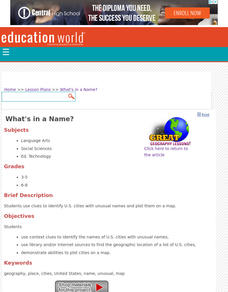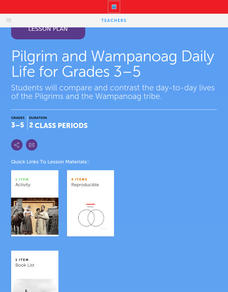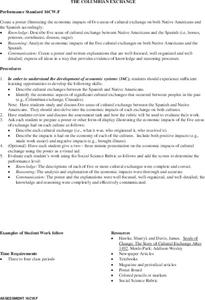Curated OER
Native American Images in the Media
Learners examine various images of Native Americans in the media. In groups, they create a list of present Native American stereotypes and what the media did to continue the stereotype. To end the instructional activity, they write in...
Curated OER
Heritage: Legends, Fairy Tales and the Native Americans
Fourth graders read a Native American legend local to the Utah region and compare it to a traditional European fairy tale. They use a Venn diagram as a graphic organizer for the comparison.
Curated OER
Native American Necklaces
First graders make an "ABB" pattern from macaroni they dyed in a previous lesson. They follow the pattern as they string the macaroni to make a necklace. This lesson is a nice math/social studies tie in.
Curated OER
Thanksgiving
First graders summarize similarities and differences of life in England and America for the Pilgrims by reading a mini-book. Then, they write a journal entry in first person on what it is like to be a pilgrim in England and in America....
Curated OER
Aquatic Roots
Young scientist use reference materials to research various local aquatic plants and or animals to find out whether they are natives or exotics. They investigate their impacts on people, other animals and the environment. High schoolers...
Curated OER
Government Protecting Rights
High schoolers explore tribal sovereignty. In this American Indian lesson, students learn about tribal sovereignty, watch a movie, take notes, and complete a reaction paper.
Curated OER
What's In a Name?
Students examine the origins of the names of U.S. states, focusing on names that were derived from Native American words. They are provided with lists of the names of the 50 states, and then research online or in library resources the...
Center for History Education
Should the Colonists Have Revolted Against Great Britain?
Should the Americans have taken the plunge and revolted against Great Britain? Using documents, including the famed Common Sense and a Loyalist response, pupils conduct a lengthy investigation of the question. The interesting resource...
Memorial Hall Museum
Problems and Events Leading Up To the Attack of 1704
Groups read primary and secondary sources detailing the ambush at Bloody Brook on September 18, 1675 and the attack on The Falls in May of 1676. After examining the results of each attack, groups reflect on the language used in the...
Curated OER
The Importance of Plants to Native Cultures in the Past and Present
Eighth graders investigate the founding and history of Sluice Boxes State Park. They use both primary and secondary resources to collect data. The focus is upon the use of native plants to make medicines. They write reports about several...
Curated OER
Forced Assimilation
Students identify ways that a society promotes assimilation and examine areas where it still occurs in our present culture. They assess the value of assimilation.
Curated OER
The First Fire : A Cherokee Animal Tale
Fourth graders discover movement through the telling of "The First Fire", a Cherokee tale. Small groups are given sections of the story to tell by creating dances. Music (live and recorded) adds to the final performance and assessment.
Scholastic
Pilgrim and Wampanoag Daily Life for Grades 3-5
Thirteen steps make up a lesson that challenges pupils to compare and contrast the daily lives of Pilgrims and the Wampanoag tribe. Learners revisit the Graffiti Wall then break into small groups for an investigative reading assignment...
Inside Mathematics
Hopewell Geometry
The Hopewell people of the central Ohio Valley used right triangles in the construction of earthworks. Pupils use the Pythagorean Theorem to determine missing dimensions of right triangles used by the Hopewell people. The assessment task...
Curated OER
How the Chipmunk Got Its Stripes: a Legend of the Iroquois
Have you ever wondered about a chipmunk's stripes? Read a short passage featuring the Iroquois legend about the chipmunk and his stripes, and answer five comprehension questions about the plot, the theme, and the unfamiliar vocabulary.
Annenberg Foundation
Egalitarian America
What does a true American represent? Scholars investigate the equal rights era of the 1960s and 1970s in the 20th installment of a 22-part series on American history. Using photographic, magazine, written, and video evidence, groups...
Curated OER
Cultural Lit. 30: The Constitution & Native Americans
Students identify and consider United States Constitutional origins in American Indian culture.
Curated OER
The Columbian Exchange
Students are introduced to the events of the Columbian Exchange. In groups, they identify and describe five main areas of cultural exchange between the Spanish and the Native Americans. They examine the economic impact of each area on...
Curated OER
Creating Stories Using Pictographs
Students participate in diverse cultural activities that lead them to a better understanding of Native American people. They use pictographs to write a story, imagining themselves as tribal members. Students transfer their story to a...
Curated OER
Dream Catchers
Students create Native American dream catchers to represent the Native American culture. After reading and discussing the origin of the Dream cather, they begin to construct their dream catchers using wire hoops, thread, beads, and...
Curated OER
The Seasons of Thanks
First graders explain the Native American cyclical concept of time
Curated OER
Dramatizing Folktales, Legends and Myths
Pupils read different folktales from Native American cultures. They work together to act out different scenes. They discover the difference between folktales, legends and myths.
Curated OER
Indian Removal
Fourth graders read The Trail of Tears and create a timeline to show the sequence of events that effected the Native American tribes during Andrew Jackson's presidency. In this Native American lesson plan, 4th graders discuss the...
Curated OER
Heritage: Petroglyphs and the Stories They Tell
Fourth graders are introduced to the use of petroglyphs as a form of communication by the Native American tribes of the region that is now Utah. They prepare their own original picture stories and then switch with a partner to translate...

























